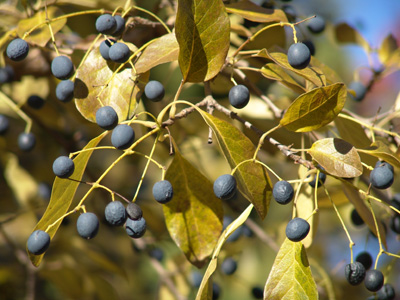In the text, Growing and Propagating Showy Native Plants, Richard E. Bir ponders why fringe tree, Chionanthus virginicus, has “been slow to become appreciated.” John Bartram introduced it to England via Peter Collinson in 1736. The Royal Horticultural Society awarded it with an award of merit 195 years later! Both C. virginicus, and its Asian cousin, C. retusus, are spectacular large shrubs or small trees for the garden.
Many common names are associated with the native Chionanthus virginicus found growing from Florida to New Jersey and west to Texas. Fringe tree, old man’s beard, and grancy greybeard all bear one commonality in extolling the fragrant white flowers which appear on last year’s growth in May. The pendulous panicles bear numerous fleecy 6-8-inch long ivory to pure white flowers. Male trees generally have more dramatic flowers. The fruits, bluish drupes, ripen in September on female plants.

Chionanthus in fruit. Photo credit: J. Jin
C. virginicus, while quite variable due to seedling variation, often takes on the habit of a multi-stemmed shrub. Expect the native fringe tree to reach 12 to 20 feet high and wide, although larger proportions are possible. Site in full sun to moderate shade. Choose a location with fertile, slightly acidic soil.
Found in China, Korea, and Japan, the Chinese fringe tree, Chionanthus retusus, differs slightly from its American cousin. The individual flowers are slightly wider resulting in a snowball or snow-like dome. The Chinese fringe tree commonly takes on a tree-like habit. Cutting back the single trunk will result in branching and a more shrub-like appearance. Flowers appear on current season’s growth and bear blue fruit on female plants. Mature plants develop a ridge-and-furrow bark pattern. Heights to 30 feet are possible.
C. retusus in bloom. Photo credit: J. Coceano
Propagation is in the development process. While the plant is prolific from seed, no two seedlings are alike in all characteristics. It is near impossible to tell a female from a male when not in fruit. Cuttings are especially difficult. Despite such obstacles, research and trials are ongoing in the effort to further promote this worthy plant.
C. virginicus (left) and C. retusus on Pearson lawn. Photo credit: J. Coceano
A beautiful specimen of C. retusus shines in the Cosby Courtyard. The single-trunk specimen is very floriferous. Outside Pearson Hall, near the Lilac Collection, one can observe firsthand the differences between C. virginicus and C. retusus. The planting showcases mature specimens of both species. Look for C. retusus ‘China Snow’ at the 2011 Scott Associates Plant Sale.
